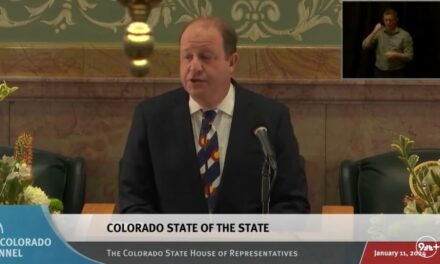We support our Publishers and Content Creators. You can view this story on their website by CLICKING HERE.
Nothing proves that what goes around comes around like presidential debates. In their last meeting, Joe Biden gratuitously slammed Donald Trump for his Covid response. In their upcoming debate this Thursday, Trump should return the favor and remind viewers of the effects Biden’s open-border policy has had on America’s fentanyl crisis.
In 2020’s final presidential debate, Biden attacked Trump for America’s 220,000 Covid deaths, saying, “Anyone who’s responsible for that many deaths should not remain as president of the United States of America,” then adding that “the president still has no comprehensive plan.”
Never mind that Covid was a global pandemic. Ditto that America’s annual Covid death totals have also been unforgiving for Biden. According to the CDC, in 2020 under Trump, 385,666 Americans died from Covid; in 2021 under Biden, 463,263 died, 246,161 died in 2022, and 51,684 died in 2023 — 761,108 in total. That averages 253,702 per year, higher than the total for which Biden criticized Trump.
Yet an even less defensible pandemic continues to sweep the country under Biden, one he has largely ignored because its origins are too politically embarrassing. According to the CDC, “overdose deaths from synthetic opioids (primarily fentanyl)” accounted for 75 percent of America’s estimated drug overdose deaths in 2023 — 81,083 of 107,543. Last year was hardly an outlier. Opioid deaths were 80,816 in 2021 and 84,181 in 2022. Biden’s first three years saw almost a quarter of a million deaths.
Illicitly manufactured and distributed, fentanyl is an extraordinarily lethal synthetic opioid. The Council on Foreign Relations wrote: “A lethal dose requires just two milligrams of the drug — an amount roughly equivalent to ten to fifteen grains of table salt.” For good reason, U.S. Drug Enforcement Administration (DEA) head Anne Milgram called it “the single deadliest drug threat our nation has ever encountered.”
While a national crisis, fentanyl disproportionately affects urban areas and black people. Cities had twice the overdose rate of other regions in their states, while black overdose rates were four to six times higher than those of whites. Finally, beyond killing more than 1,500 Americans weekly, Congress’s Joint Economic Committee estimated it cost America $1.5 trillion in 2020.
Fentanyl’s origins are equally well known. Precursor chemicals come from China; they are manufactured into fentanyl in Mexico; drug cartels then smuggle it across our southern border. Its extreme strength makes for easy transport in small quantities. The median weight seized is just 1.2 kilograms, but that’s enough for 50,000 lethal doses.
Despite its carnage, cost, and countries being recognized, Biden switched course from previous administrations. The Economist stated: “In 2021, for the first time, the government spent more on treatment and prevention than on trying to reduce the supply of drugs.” Vanda Felbab-Brown of the Brookings Institution wrote: “The emphasis on treatment, prevention, and harm reduction dominates the administration’s new drug policy plan.”
Biden’s switch from interdiction to prevention fit neatly with his political priorities, particularly opening the southern border. Simply, he could not open the southern border to illegal immigrants and seek to close it to illegal opioids at the same time. So illegal immigration prevailed.
This intersection of policy and politics, immigration and fentanyl, has played out further as the election loomed. In November 2023, Biden announced an agreement with China regarding fentanyl. Just recently, he announced a new immigration policy. Both are less than meets the eye.
In its reporting of the China deal, the BBC quoted Thomas Bollyky, “a former US trade official and veteran of negotiations with China,” as cautioning that while “the central government is ‘capable’ of effectively cracking down on chemical firms involved in the fentanyl trade. The bigger question is if ‘it’s a sufficient priority.’”
Almost three years into his presidency, it’s fair to put the same question to Biden’s administration. Certainly, it’s not been one for China, as Brown from Brookings testified a year ago: “…in August 2022, China officially announced that it suspended all of its counternarcotics and law enforcement cooperation with the United States.”
Mexico has been similarly uncooperative. It has both denied responsibility and hindered U.S. law enforcement efforts south of the border. Similar to his recently heightened interest in China, Biden’s interest in Mexico rose with the election’s proximity. His latest border initiative — which undermines his prior argument that he was unable to act unilaterally — essentially formalizes America’s illegal immigration crisis. An NPR headline sums it up: “Biden’s new asylum rule would have ‘minimal’ impact on unauthorized border crossings.”
Concerning fentanyl, Biden has done what Biden does: facile policy feints that serve his political priorities, while ignoring the obvious source. He has because recognizing it would require admitting his minimal influence with America’s primary adversary, despite its role in tens of thousands of American deaths annually, and his unwillingness to secure the border over which fentanyl pours.
More than 58,000 Americans died in Vietnam. Their names are rightfully inscribed on a wall on the National Mall in Washington. Sadly, four times more have died from fentanyl overdoses during Biden’s presidency. Yet there is no wall on the National Mall to them. And thanks to Biden, there is no wall on the southern border either.
J.T. Young was a professional staffer in the House and Senate from 1987-2000, served in the Department of Treasury and Office of Management and Budget from 2001-2004, and was director of government relations for a Fortune 20 company from 2004-2023.

 Conservative
Conservative  Search
Search Trending
Trending Current News
Current News 





